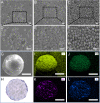Microfluidic fabrication of X-ray-visible sodium hyaluronate microspheres for embolization
- PMID: 37435366
- PMCID: PMC10331790
- DOI: 10.1039/d3ra02812g
Microfluidic fabrication of X-ray-visible sodium hyaluronate microspheres for embolization
Abstract
Catheter embolization is a minimally invasive technique that relies on embolic agents and is now widely used to treat various high-prevalence medical diseases. Embolic agents usually need to be combined with exogenous contrasts to visualize the embolotherapy process. However, the exogenous contrasts are quite simply washed away by blood flow, making it impossible to monitor the embolized location. To solve this problem, a series of sodium hyaluronate (SH) loaded with bismuth sulfide (Bi2S3) nanorods (NRs) microspheres (Bi2S3@SH) were prepared in this study by using 1,4-butaneglycol diglycidyl ether (BDDE) as a crosslinker through single-step microfluidics. Bi2S3@SH-1 microspheres showed the best performance among other prepared microspheres. The fabricated microspheres had uniform size and good dispersibility. Furthermore, the introduction of Bi2S3 NRs synthesized by a hydrothermal method as Computed Tomography (CT) contrast agents improved the mechanical properties of Bi2S3@SH-1 microspheres and endowed the microspheres with excellent X-ray impermeability. The blood compatibility and cytotoxicity test showed that the Bi2S3@SH-1 microspheres had good biocompatibility. In particular, the in vitro simulated embolization experiment results indicate that the Bi2S3@SH-1 microspheres had excellent embolization effect, especially for the small-sized blood vessels of 500-300 and 300 μm. The results showed the prepared Bi2S3@SH-1 microspheres have good biocompatibility and mechanical properties, as well as certain X-ray visibility and excellent embolization effects. We believe that the design and combination of this material has good guiding significance in the field of embolotherapy.
This journal is © The Royal Society of Chemistry.
Conflict of interest statement
There are no conflicts to declare.
Figures







Similar articles
-
The sodium hyaluronate microspheres fabricated by solution drying for transcatheter arterial embolization.J Mater Chem B. 2022 Jun 1;10(21):4105-4114. doi: 10.1039/d2tb00413e. J Mater Chem B. 2022. PMID: 35531617
-
Microfluidic-prepared, monodisperse, X-ray-visible, embolic microspheres for non-oncological embolization applications.Lab Chip. 2020 Oct 7;20(19):3591-3600. doi: 10.1039/d0lc00098a. Epub 2020 Sep 1. Lab Chip. 2020. PMID: 32869821 Free PMC article.
-
Synthesis and characterization of cadmium-bismuth microspheres for the catalytic and photocatalytic degradation of organic pollutants, with antibacterial, antioxidant and cytotoxicity assay.J Photochem Photobiol B. 2020 Jan;202:111723. doi: 10.1016/j.jphotobiol.2019.111723. Epub 2019 Nov 23. J Photochem Photobiol B. 2020. PMID: 31785448
-
X-ray visible and uniform alginate microspheres loaded with in situ synthesized BaSO4 nanoparticles for in vivo transcatheter arterial embolization.Biomacromolecules. 2015 Apr 13;16(4):1240-6. doi: 10.1021/acs.biomac.5b00027. Epub 2015 Mar 9. Biomacromolecules. 2015. PMID: 25728288
-
Silica-coated bismuth sulfide nanorods as multimodal contrast agents for a non-invasive visualization of the gastrointestinal tract.Nanoscale. 2015 Aug 7;7(29):12581-91. doi: 10.1039/c5nr03068d. Epub 2015 Jul 6. Nanoscale. 2015. PMID: 26145146
Cited by
-
Development and evaluation of polyacrylamide microspheres loaded with phloretin and tantalum for transcatheter arterial embolization.RSC Adv. 2023 Dec 5;13(50):35429-35434. doi: 10.1039/d3ra05841g. eCollection 2023 Nov 30. RSC Adv. 2023. PMID: 38058558 Free PMC article.
-
99mTc/90Y radiolabeled biodegradable gel microspheres for lung shutting fraction assessment and radioembolization in hepatocellular carcinoma theranostics.Mater Today Bio. 2024 Nov 27;29:101367. doi: 10.1016/j.mtbio.2024.101367. eCollection 2024 Dec. Mater Today Bio. 2024. PMID: 39687798 Free PMC article.
References
-
- Wang Y. L. He X. L. Zhou C. Bai Y. W. Li T. Q. Liu J. C. Ju S. G. Wang C. Y. Xiang G. Y. Xiong B. Acta Biomater. 2022;154:536–548. - PubMed
-
- Perez Lopez A. Martin Sabroso C. Gomez Lazaro L. Torres Suarez A. I. Aparicio Blanco J. Acta Biomater. 2022;149:1–15. - PubMed
-
- Li X. H. Ullah M. W. Li B. S. Chen H. R. Adv. Healthcare Mater. 2023;41:2202787.
LinkOut - more resources
Full Text Sources

